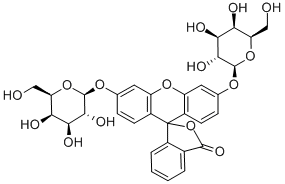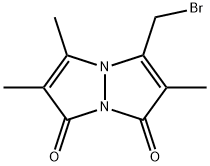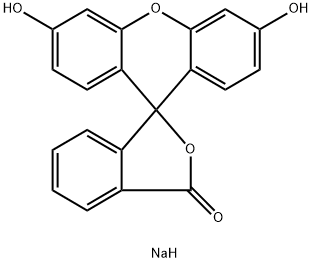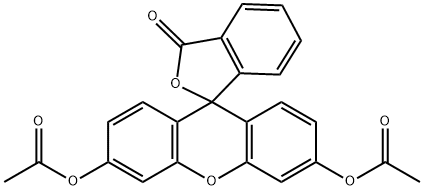FDG
Synonym(s):FDG
- CAS NO.:17817-20-8
- Empirical Formula: C32H32O15
- Molecular Weight: 656.59
- MDL number: MFCD00077344
- EINECS: 1312995-182-4
- SAFETY DATA SHEET (SDS)
- Update Date: 2025-12-16 21:30:20

What is FDG?
The Uses of FDG
For detecting Glycosidases and could be used in ELISAs, FDG substrate has also been used for identifying lacZ-positive cells with fluorescence microscopy and flow cytometry
The Uses of FDG
Ultra sensitive fluorogenic substrate for ?-galactosidase, used in live cell and tissue (in vivo and in vitro) assays. This fluorescent substrate reagent could be used for monitoring kinetics of hydrolysis.
The Uses of FDG
Fluorescein di(β-D-galactopyranoside) (FDG) has been used for the detection of gene expression via FACS (fluorescence-activated cell sorting).
What are the applications of Application
Fluorescein di(β-D-galactopyranoside) is a fluorogenic substrate for β-galactosidase
Biochem/physiol Actions
Fluorescein di (β-D-galactopyranoside) (FDG) results in fluorescence after being hydrolyzed to fluorescein by β-galactosidase. It gives fluorescence proportional to the enzymatic activity. This molecule is mainly required for the detection of gene expression in transfected cells when using β-galactosidase (Lac Z) as a reporter gene.
Properties of FDG
| Melting point: | 200-203 °C (dec.) |
| Boiling point: | 974.8±65.0 °C(Predicted) |
| Density | 1.74±0.1 g/cm3(Predicted) |
| storage temp. | -20°C |
| solubility | DMSO: soluble |
| form | A solid |
| pka | 12.44±0.70(Predicted) |
| color | Yellow to orange |
Safety information for FDG
| Signal word | Warning |
| Pictogram(s) |
 Exclamation Mark Irritant GHS07 |
| GHS Hazard Statements |
H315:Skin corrosion/irritation H319:Serious eye damage/eye irritation H335:Specific target organ toxicity, single exposure;Respiratory tract irritation |
| Precautionary Statement Codes |
P261:Avoid breathing dust/fume/gas/mist/vapours/spray. P280:Wear protective gloves/protective clothing/eye protection/face protection. |
Computed Descriptors for FDG
New Products
Indole Methyl Resin tert-butyl 9-methoxy-3-azaspiro[5.5]undecane-3-carboxylate Boc-His(Boc)-OH 2-CTC Resin 4-Chloro-7-tosy1-7Hpyrrolo[2,3-d]pyrimidine 5,7-Dibromo-1H-indole 2,5-dichloro-N-hydroxy-4,6-dimethylpyridine-3-carboximidamide 2,2-Dimethoxy-7-azaspiro[3.5]nonane hydrochloride 4-chloromethyl-5-methyl-1,3-dioxol-2-one (DMDO-Cl) R-2-BENZYLOXY PROPIONIC ACID 1,1’-CARBONYLDIIMIDAZOLE 1,1’-CARBONYLDI (1,2-4 TRIAZOLE) N-METHYL INDAZOLE-3-CARBOXYLIC ACID 4-((2-hydroxyethyl)thio)benzoic acid 1-(TERT-BUTOXYCARBONYL)-2-PYRROLIDINONE Methyl 6-methylnicotinate 3-Pyridineacrylic acid tert-Butyl carbazate TETRAHYDRO-2H-PYRAN-3-OL 2-((4-morpholinophenylamino) (methylthio) methylene) malononitrile 3-(4-morpholinophenylamino)-5-amino-1H-pyrazole-4-carbonitrile 2,4-dihydroxybenzaldehyde 1,3-Diethyl-1,3-Diphenylurea Methyl 2-methylquinoline-6-carboxylateRelated products of tetrahydrofuran




![Fluorescein dicaprylate [Fluorescein dioctanoate]](https://img.chemicalbook.in/)



You may like
-
 Fluorescein di(β-D-galactopyranoside) CAS 17817-20-8View Details
Fluorescein di(β-D-galactopyranoside) CAS 17817-20-8View Details
17817-20-8 -
 Pyridine 99.5% HPLC /UV SpectroscopyView Details
Pyridine 99.5% HPLC /UV SpectroscopyView Details
110-86-1 -
 Guanine , 99%View Details
Guanine , 99%View Details
73-40-5 -
 Piperazine Spot supply, best priceView Details
Piperazine Spot supply, best priceView Details
110-85-0 -
 Dibutyl PhthalateView Details
Dibutyl PhthalateView Details
84-74-2 -
 Imidazole Spot supply, competitive priceView Details
Imidazole Spot supply, competitive priceView Details
288-32-4 -
 Octadecyl 3-(3,5-di-tert-butyl-4-hydroxyphenyl)propionate 98% (GC)View Details
Octadecyl 3-(3,5-di-tert-butyl-4-hydroxyphenyl)propionate 98% (GC)View Details
2082-79-3 -
 Thiourea 99% ARView Details
Thiourea 99% ARView Details
62-56-6
